Project details
Skill
Cost
Estimated Time
Mini-split air conditioning and heat pump systems offer an efficient solution for heating and cooling homes. These versatile units provide targeted climate control without the need for extensive ductwork, making them ideal for older homes, additions, or spaces where traditional HVAC systems are impractical.
In this article, we explore the ins and outs of mini-split systems and walk through the installation process. The video above shows This Old House plumbing and heating expert Richard Trethewey demonstrating the installation of a mini-split system, highlighting its benefits and the expertise required for proper setup.
How Does a Mini Split Heat Pump Work?
It’s simple physics — heat will always transfer to cold. A mini-split uses an inverter to capture heat through a cold line of refrigerant and move it to the desired location.
In the summer, heat is extracted from the air in the house and dumped outside, making it cold. In the winter, heat is scavenged from the outside and pushed back into the house. This creates heating and cooling year-round.
Because there are no ducts to retrofit, the system is simple for a pro to install. And it provides excellent dehumidification, quiet operation, and great efficiency.
Advantages of Mini-Split Systems
Mini-split systems offer several benefits over traditional HVAC options:
- Ductless design for easy installation
- Zoned climate control for customized comfort
- High energy efficiency
- Quiet operation
- Excellent dehumidification capabilities
- Remote control operation
Sizing and Capacity
A single air handler can typically heat or cool up to 1,000 square feet, depending on the climate and system size. For larger spaces, multiple indoor units can be connected to a single outdoor condenser, allowing for zoned comfort throughout the home. Properly sizing the system is crucial for optimal performance and efficiency.
Planning Your Mini-Split Installation
Before installing a mini-split system, careful planning is essential to ensure optimal performance and aesthetics.
Choosing the Right Location
Selecting appropriate locations for both the indoor and outdoor units is critical. Consider the following factors.
- Indoor unit placement: Choose a central location on an interior wall, ideally 2⅛ inches below the ceiling and away from direct sunlight or heat sources.
- Outdoor unit placement: Find a shaded area with at least 4 inches of clearance behind and 20 inches above and in front of the unit.
- Line set routing: Plan the most efficient and discreet path for refrigerant lines between units.
Electrical Considerations
Mini-split systems require a dedicated electrical circuit. Ensure your home’s electrical panel can accommodate the additional load, and plan to install a disconnect box near the outdoor unit. Your installation professional will be able to either handle this or help you find an electrician to do the job.
Condensate Drainage
Proper condensate drainage is crucial for preventing water damage and mold growth. Plan for a gravity-fed drain line, or consider installing a condensate pump if necessary.
Permits and Regulations
Before beginning the installation, be sure to check local building codes and regulations. Acquire necessary permits and adhere to all guidelines to ensure the installation is compliant and safe. This will help avoid fines and complications and ensure that the system operates correctly.
Mini-Split Installation Process
Installing a mini-split system is a complex task best left to qualified professionals. However, understanding the process can help you make informed decisions and ensure quality work.
Step 1: Install the Condenser
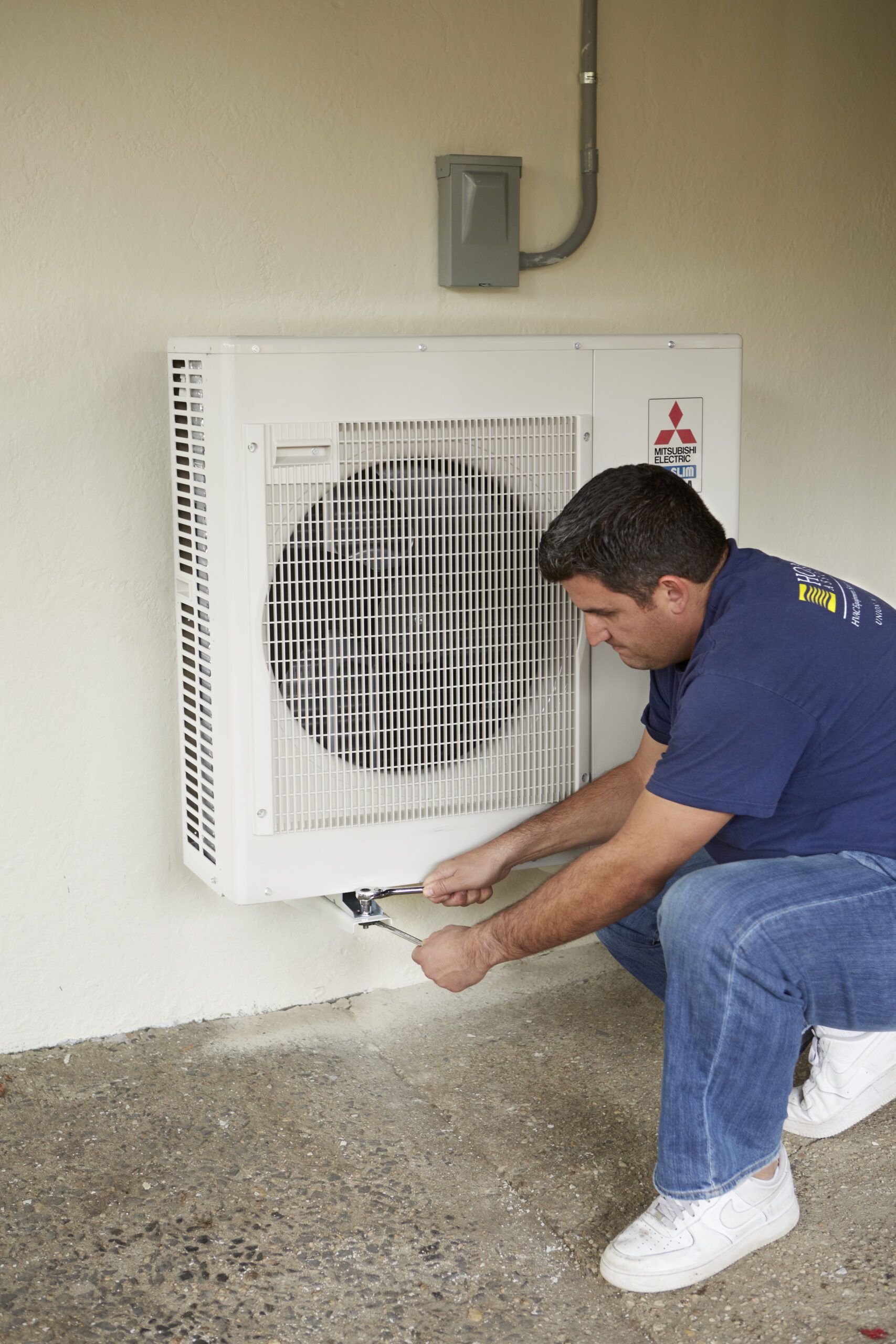
Pictured: Mark Pauletti of Arctic Mechanical, in Port Chester, New York, uses the remote to check the airflow from the indoor unit.
The condenser should be placed in a shaded location outside the house where it can have at least 4 inches of clearance behind it and 20 inches of clearance above it and in front of it. This heavy unit can be mounted on brackets fastened to the wall, as shown, or bolted to concrete blocks resting on the ground.
Step 2: Locate the Air Handler

The air handler mounts on the inside of an exterior wall no more than 33 feet from the outdoor unit, at least 2⅛ inches below the ceiling, and 3 feet from a TV. First, the mounting plate is screwed to the studs, as shown. At the plate’s lower-right corner, the installer drills through the wall with a 3-inch hole saw. Outside, a connecting hole is drilled ¼ inch below the one inside.
Step 3: Mount the Air Handler
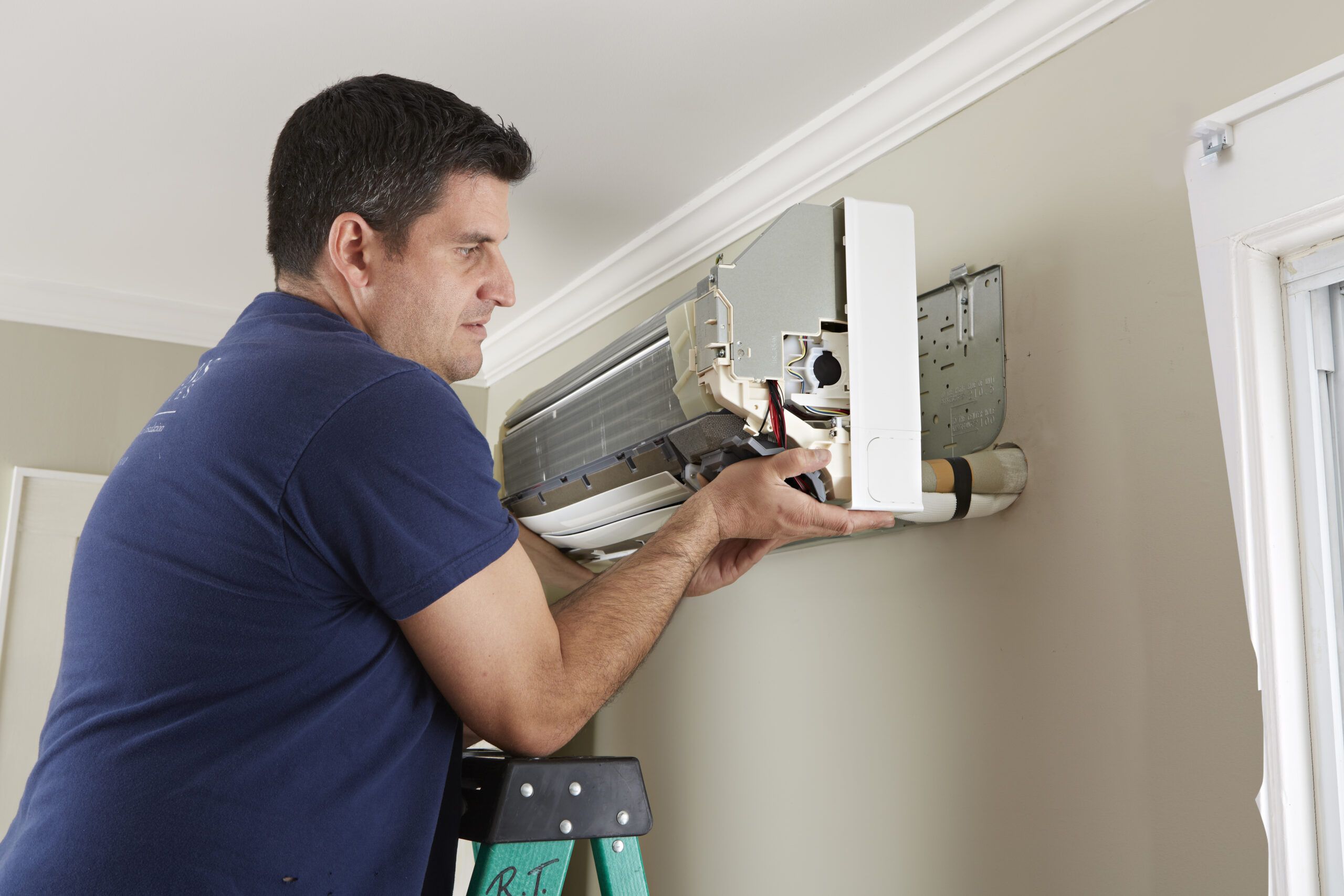
With the cover off, the control wire, refrigerant lines, and condensate drain hose are attached to the unit and taped together, and a protective sleeve is fitted into the hole in the wall. The unit is hoisted up without its fins being touched, and the taped parts are fed through the sleeve, as shown. The unit then mounts to the plate.
Step 4: Set Up the Condenser
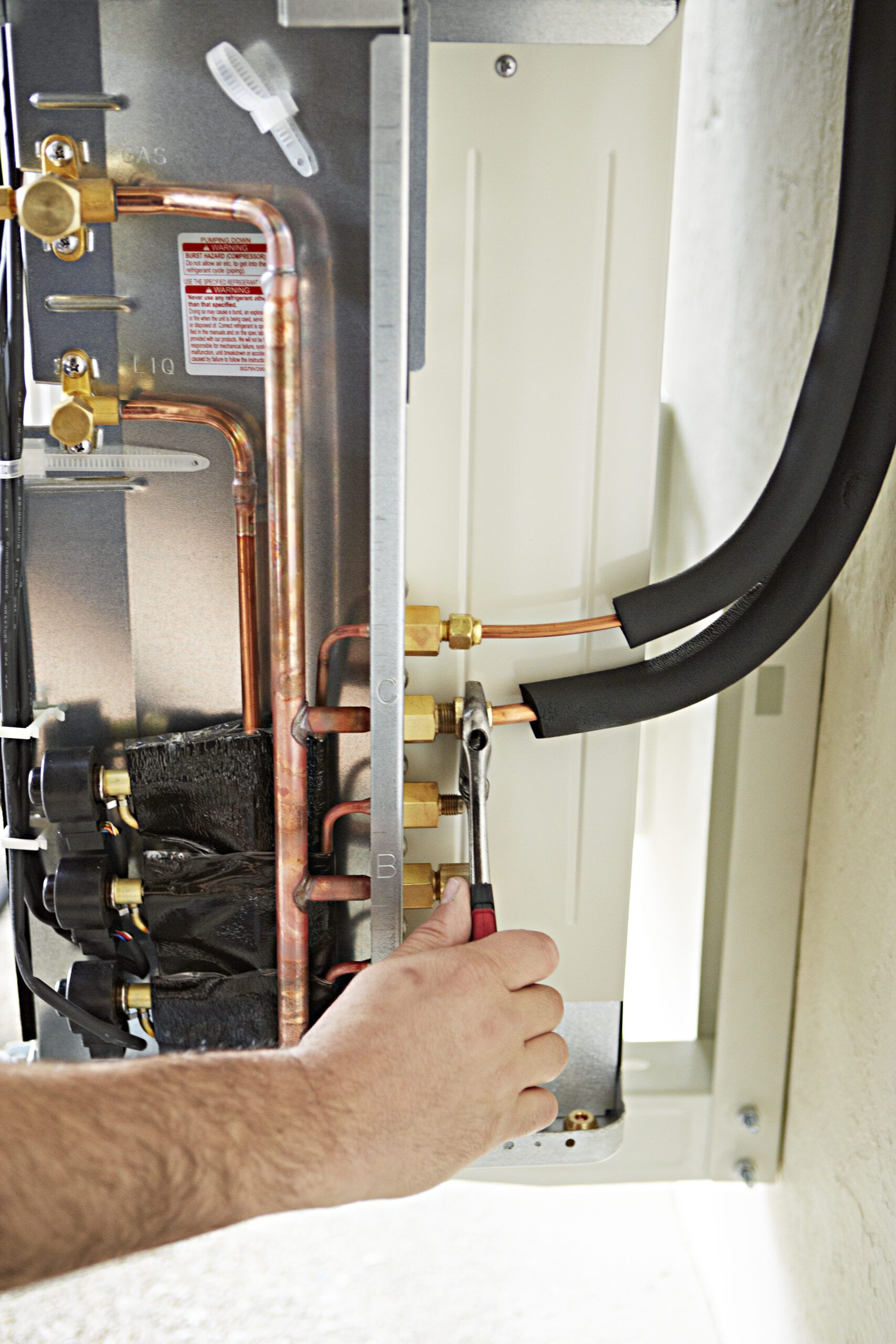
The outdoor unit is connected to the control wire from the indoor unit and to a jacketed power cable leading to the breaker panel. Then the ends of the refrigerant lines are fastened to the condenser with flare nuts, as shown. Flare nuts are also used to join these lines to the ones on the indoor unit.
Step 5: Hide the lines
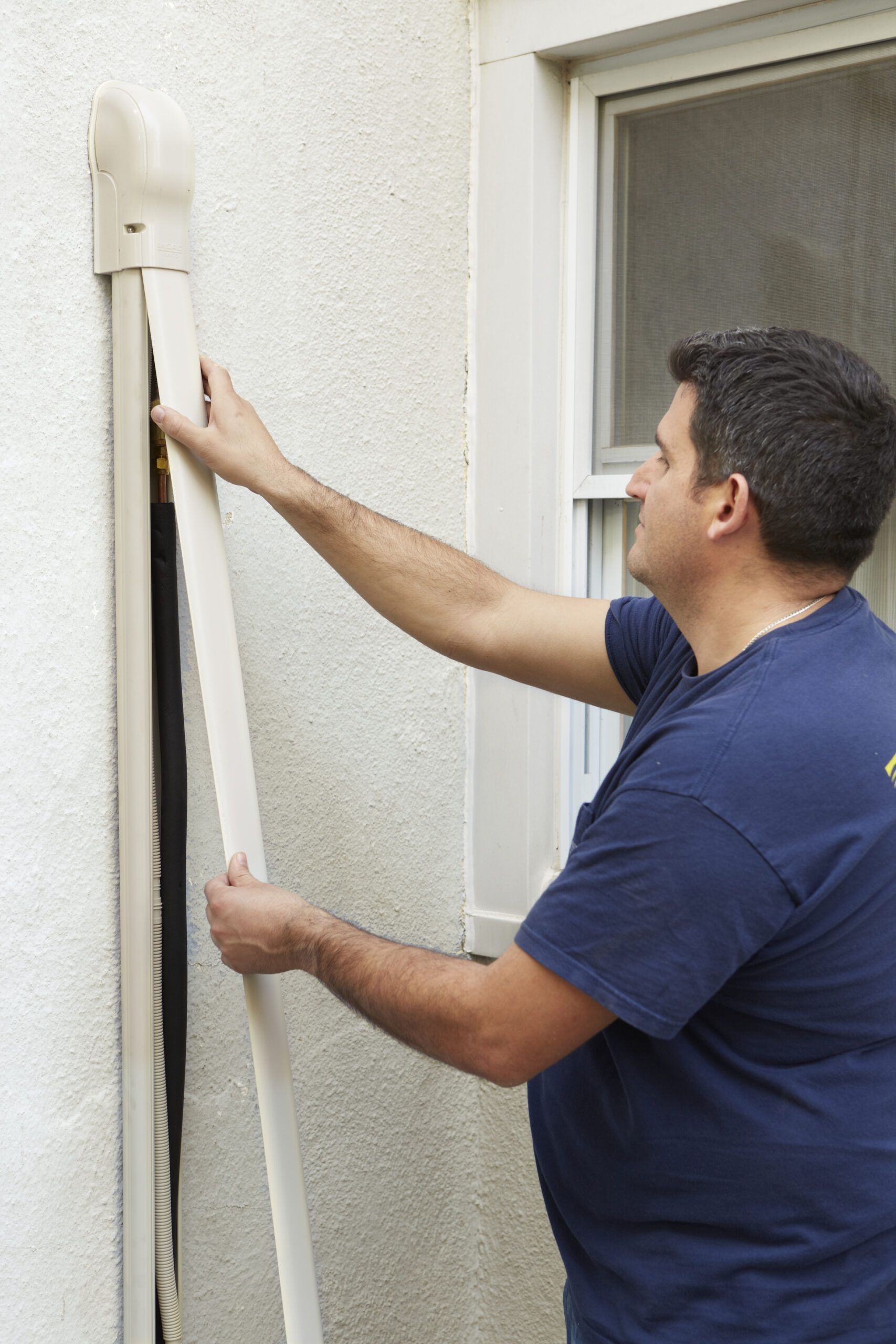
A plastic channel screwed to the siding hides the lines, condensate hose, and control wire. After the hose is checked to make sure it drains freely, the end of the hole sleeve is sealed with silicone to prevent water infiltration. Then, the channel is capped, as shown.
Step 6: Pump and Cover
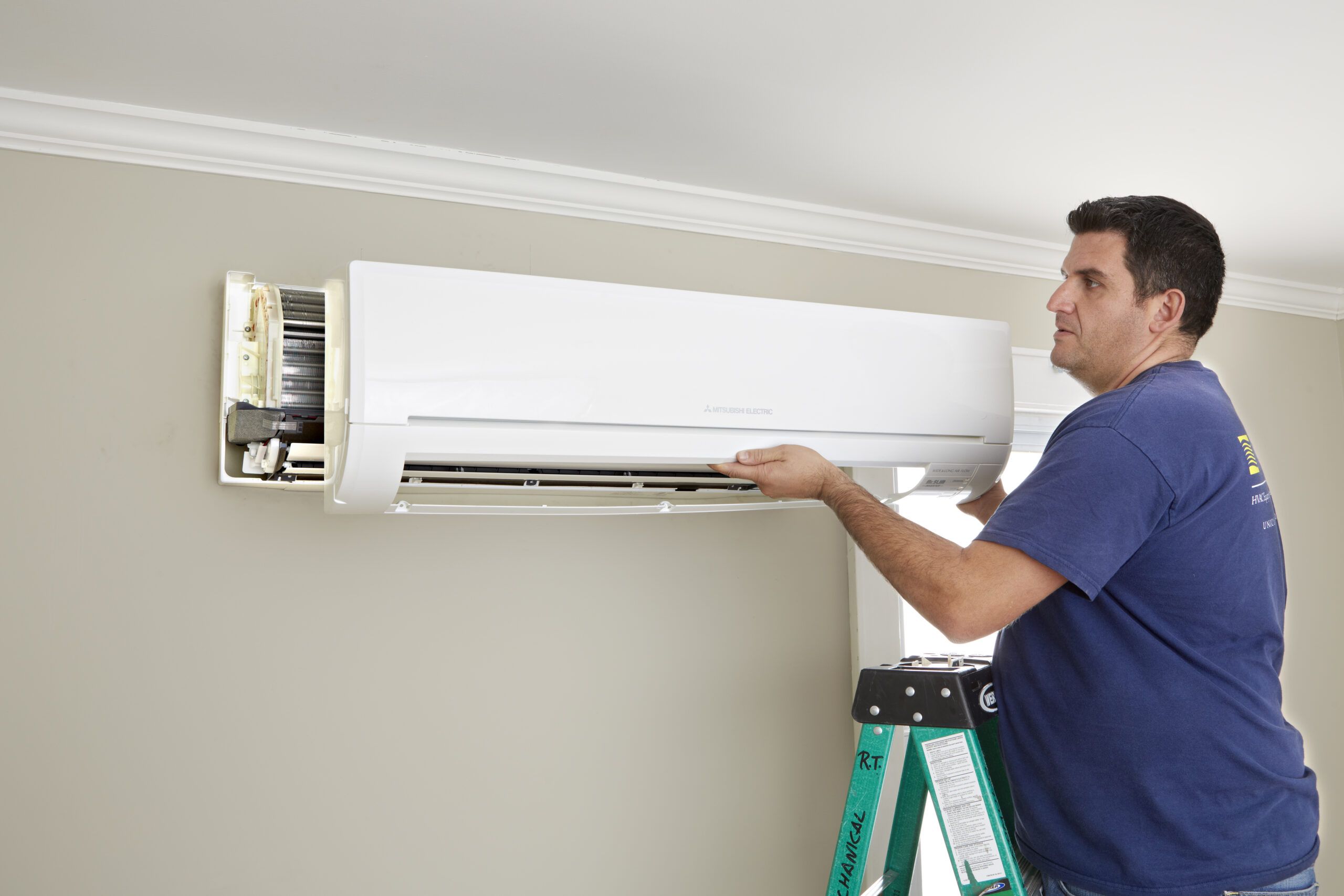
A gauge manifold and a vacuum pump are hooked up to the refrigerant lines to detect leaks and dry the lines as refrigerant is pumped into them. The last step is to put the cover on the air handler, as shown. The system is then ready to heat and cool.
System Charging and Testing
- Use a gauge manifold and vacuum pump to check for leaks and remove moisture from the lines.
- Charge the system with refrigerant according to manufacturer specifications.
- Test the system for proper operation and make any necessary adjustments.
In the video, Richard explains the importance of professional installation, as the process involves specialized tools and expertise to ensure optimal performance and efficiency.
Mini-Split System Maintenance and Care
Regular maintenance is essential to keep your mini-split system running efficiently. Routine cleaning includes:
- Cleaning or replacing air filters monthly.
- Wiping down the indoor unit’s exterior with a damp cloth periodically.
- Keeping the area around the outdoor unit clear of debris and vegetation.
- Inspecting and cleaning the lines for any obstructions that might hinder the unit’s efficiency.
You should also schedule annual professional maintenance to:
- Check refrigerant levels and pressure
- Clean evaporator and condenser coils
- Inspect electrical connections
- Ensure proper system operation
Regular professional checks will identify potential issues before they become serious, prolonging the life of the unit.
Troubleshooting Common Issues
While mini-splits are generally reliable, some common issues may arise:
- Inadequate cooling or heating: Check for dirty filters or blocked airflow.
- Strange noises: Listen for unusual sounds that may indicate loose components or debris in the fan.
- Water leaks: Inspect the condensate drain line for clogs or damage.
- Unresponsive controls: Ensure batteries are fresh in the remote and that the unit is receiving power.
If you encounter persistent problems, contact a qualified HVAC technician for assistance.
Mini-Split System Cost Considerations
The cost of installing a mini-split system can vary widely depending on factors such as system size, number of indoor units, and installation complexity. Generally, homeowners can expect to pay between $2,000 and $14,500 for a complete mini-split system installation, according to Angi.
Factors affecting the cost include:
- System size: Larger systems with more capacity tend to be more expensive.
- Number of indoor units: More units mean higher costs.
- Installation complexity: Difficult installations requiring additional work or customization may increase labor costs.
- Electrical upgrades: Ensuring your electrical system can handle the new unit can add to the overall expense.
- Brand and features: Premium brands with advanced features might carry a higher price tag.
While the initial investment may be higher than some traditional HVAC options, mini-splits often provide long-term savings through increased energy efficiency and targeted climate control.
Our Conclusion
Mini-split AC heat pump systems offer an efficient and flexible solution for home climate control. While professional installation is necessary, understanding the process and benefits can help homeowners make informed decisions about their HVAC needs. With proper planning and maintenance, a mini-split system can provide years of comfortable, energy-efficient heating and cooling.
